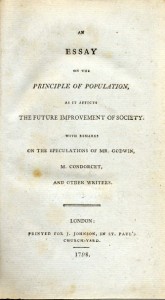9.2 The Dismal Science
The late 18th century was a period of unprecedented intellectual excitement. Revolutions associated with political power structures were driven by new ideas that were themselves revolutionary. Political ideas like democracy and those set out in Thomas Paine’s Rights of Man proposed to overturn the fundamental relationships between social classes and centuries-old notions of both deference and noblesse oblige. At the same time, new fields of study were emerging that would challenge the power of older institutions. Geology threatened the Christian belief in a world that was a mere 4,000 years old; three centuries of refining navigational tools had produced the equipment necessary to look into space and into individual cells. The world was about to become much older, much newer, much larger, and much smaller at the same time.
Economics, as well, was about to emerge as an arena of serious study and debate as early practitioners searched for overarching principles and values that would help them formulate the right questions before rushing off in search of the right answers. Two influential British figures in this respect deserve mention: Thomas Malthus and Adam Smith.
Malthus and the Agricultural Revolution

Thomas Robert Malthus (1766-1834) was a smalltown vicar concerned with the relationship between famine and population growth. In 1798 he published An Essay on the Principle of Population, in which he argued that population growth would always be reined in by positive restraints that raise the death rate and negative checks that lower the birth rate. It is thanks to Malthus that economics acquired the title “the dismal science,” because he could see no morally defensible way around a cycle of increased food production followed by population booms and then by famine and collapse. (As a vicar, he could not entertain the notion of birth control, although he did advocate for personal sexual restraint.)
Malthus was proved wrong, at least for two centuries. Food production could increase more rapidly than he anticipated and fertility rates would, simultaneously and against all predictions, drop significantly in the industrializing world. But Malthus provides an important window into how people in the late 18th and early 19th centuries understood the world around them. Famines had wracked Europe for centuries and Malthus’s generation bore witness to them. And the last major famine in the British Isles — the Irish Potato Famine of the 1840s — was yet to come. People who thought about economies understood shortages not as mere inconveniences that might run the price up a bit, but as terrible events they had seen in their lifetimes, the kind of thing that led to violence, starvation, and mass die-offs. Malthus posited a scientific system for understanding why this was so, why prosperity and growth seemed always to be followed by starvation, war, and mortality.

There was something else that Malthus observed without necessarily realizing it. When he wrote about increases in agricultural output he did so in the context of the agricultural revolution. Food productivity had been climbing steadily in Europe and North America since about 1700. More effective farming techniques and different landhold patterns lay behind these changes, as did improved infrastructure and thus better communication between markets and farmers. Whether he knew it or not, the rate of agricultural increase that he described as a fact was, in reality, part of his own historical context. Earlier generations simply could not have imagined the rate of food production growth that lay at the heart of Malthus’s model.
Malthus and many of his contemporaries were keenly aware of one other truth: Britain’s population was surging. It had nearly doubled in the 18th century; more than 4 million people had been added. It was this growth that would spur enormous economic changes in Britain and provide the fuel for an explosion of immigration to British North America and other colonies.
An Economic Revolution
In short, ideas about the economy were evolving at a time when the economy itself was transforming. In our own era, we are accustomed to the idea of change, not least because we can look back on a record of nearly 300 years of significant change. But in the late 18th century change was still rather frightening. Centuries of feudal relations and food production were only just beginning to face challenges. Absolutism was, until the 1780s, impregnable across Europe. Colonies followed the direction of empires and both France and Britain were very conservative in this respect. The vast majority of humans lived on the land. With the exception of small numbers of emigrants to the colonies, farming people stayed put; people mostly lived, married, and died in the village of their birth. It was rare for Europeans to travel far unless they were wealthy or in an army.
North America changed all of that. Revolution in the British colonies was both stimulated by and responsible for emergent ideas about government and citizenship. What followed in France was more than an echo in that it rocked to its foundations the very idea of absolutist government and an aristocracy. Additionally, the Americas were the scene of widespread experimentation with non-feudal landholding systems that produced dramatically higher surpluses. The modest family farm of New England and Upper Canada would be a conceptual force strong enough to topple whole regimes in Europe. The mass production possible in slave colonies, moreover, created a need for bigger and better freight shipping, warehousing, and processing. In the 1770s and 1790s important technological changes in the processing of raw cotton and the weaving of cotton cloth transformed overnight the plantations of the American South, causing an explosion in technology that would lead ultimately to wholesale industrialization around the North Atlantic.
The principal beneficiaries of all this activity were the advocates of mercantilism. The merchants and shipowners of Europe’s westward-facing ports had enjoyed 200 years of accumulating wealth in trade between North America and the empire. Their money — their capital — was now substantial, and they were beginning to invest in projects that had nothing to do with fishing boats or beaver pelts. What British historian Eric Hobsbawm called “the age of revolution” that began in the second half of the 18th century would, thus, have many and widespread ramifications, not the least of which were economic.[1]

Classical Liberal Economics
Adam Smith (1723-1790) had a thing or two to say on these topics. His 1776 book, generally known by the shortened title The Wealth of Nations, argued for the free movement of investment. Removing constraints and allowing capital to be invested where profits are likely to be greatest would produce economic growth for the greater good of the nation, he argued. This was a revolutionary proposition in a world governed by tariffs and Navigation Acts; it was revolutionary, too, in that it called for the betterment of “the nation” rather than the Crown. To much of the European and even the North American establishment, wealth rightly belonged to those of good birth and royal favour. Handing power over the economy to mere merchants and capitalists was akin to handing them a loaded gun. Nevertheless, new schools of economic thought advocating a liberal approach were on the rise and they challenged efforts to conserve the old order of economic power.
The wars in Europe arising from the French Revolution and then the Napoleonic era postponed the peacetime necessary to test some of the theories of Malthus and Smith, but it was during this 30-year period of instability that many of the key economic changes took root. As is often the case, the wars presented opportunities to build capacity for production because the state reliably demanded large quantities of goods for its troops. Wool production increased in Europe; cotton production increased in the American South; timber, shipping, and fisheries production increased dramatically in British North America. Then, in 1818, it all collapsed.
The 19th century opened, then, with a flurry of new ideas. The United States was a democracy, a republic, and a nation state. There was no crown to enrich or serve, no suggestion that the president was infallible due to the kind of divine right enjoyed by Louis XIV in France. Britain might be known as the United Kingdom, but the power of its kings had never been more compromised than it was under George III. France, of course, had become a republic and would spend the next hundred years reinventing itself as a secular democracy and, again, a nation state. What then was the purpose of the economy in a colony? How might it grow and to what end?
Key Points
- The 19th century arrived on the heels of challenging new ideas about the nature of the economy, the relationship between the individual and the state, and how best to meet the needs of growing populations.
- Merchants in Europe and North America were in a position to provide investment capital that could finance independent and state projects without the involvement of the Crown.
- There was growing interest in eliminating tariffs so that British producers could compete more aggressively in global markets.
Attributions
Figure 9.1
An Essay on the Principle of Population by Lupo is in the public domain.
Figure 9.2
Malthusian catastrophe by Kravietz is used under a CC-BY-SA 3.0 license.
Figure 9.3
AdamSmith by Protonk is in the public domain.
Long Descriptions
Figure 9.2 long description: A graph comparing the rate of population growth and the production of food, according to Malthus. The production of food rises at a steady but gradual rate while population grow exponentially. The point on the graph where population surpasses food production is labeled, “Malthusian Catastrophe” [Return to Figure 9.2]
- Eric Hobsbawm, Age of Revolution, 1789-1848 (NY: Vintage Books, 1962, 1996). ↵

